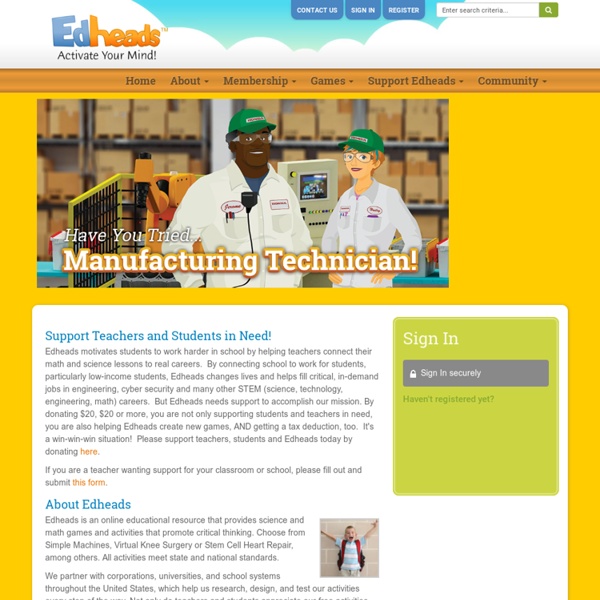Newton's 3 Laws of Motion
Problem: Does height of a ramp affect the distance a hot wheels car will travel? Hypothesis: I think that ... because ... Materials: one meter ramp hot wheels car meter stick 4 science books science journal and pencil Procedure: Build the ramp one science book high. Place the hot wheels car at the starting point and release.
The Field Book Project
What is a field book? Field books or field notes are primary source documents that describe the events leading up to and including the collection of specimens or observations during field research. Field notes can take many forms depending on the information needs of the collector. Importance and challenges of field books Field notes are significant sources of information related to scientific discovery. They provide rich data for researchers to understand how biodiversity has changed over time and space.
Collaborative Tools
Skip to main content Create interactive lessons using any digital content including wikis with our free sister product TES Teach. Get it on the web or iPad! guest Join | Help | Sign In
Straw Bridges - Activity - www.teachengineering.org
Summary Working as engineering teams, students design and create model beam bridges using plastic drinking straws and tape as their construction materials. Their goal is to build the strongest bridge with a truss pattern of their own design, while meeting the design criteria and constraints. They experiment with different geometric shapes and determine how shapes affect the strength of materials. Let the competition begin! Engineering Connection
Air Resistance > Experiment #13 from Physics with Vernier
Recommended for High School. Loaded: 0% Progress: 0% Introduction
125 Great Science Videos: From Astronomy to Physics & Psychology
Astronomy & Space Travel A Brief, Wondrous Tour of Earth (From Outer Space) - Video - Recorded from August to October, 2011 at the International Space Station, this HD footage offers a brilliant tour of our planet and stunning views of the aurora borealis.A Universe from Nothing - Video - In 53 minutes, theoretical physicist Lawrence Krauss answers some big enchilada questions, including how the universe came from nothing.A Year of the Moon in 2.5 Minutes - Video - The Lunar Reconnaissance Orbiter has been orbiting the moon for over a year. The footage gets compressed into 2 slick minutes.A Day on Earth (as Seen From Space) - Video - Astronaut Don Pettit trained his camera on planet Earth, took a photo once every 15 seconds, and then created a brilliant time-lapse film.Atlantis's Final Landing at Kennedy Space Center - Video - After more than 30 years, the space shuttle era comes to a close. Video runs 30 minutes.
Reading Lessons: 12 Ways to Scaffold Texts for Students
Would you dump a load of building supplies on a lot and tell a random person to "build a house"? Hopefully not! For the same reason, it is unwise to deposit an academic novel and some study guide questions on a student’s desk and say, “read it.” Student readers, like builders, need a foundation and a blueprint to be successful. Getting students to read academic novels can be difficult. Students usually lack interest in “school” books for three reasons:
Mars Exploration Program: Mars for Educators
You can participate in four major programs: Curriculum Supplements Robotics activities are available. Download the activity summaries (PDF, 1.33 MB) or the full activity set (PDF, 1.08 MB). The Mars Curriculum Modules are designed to help bring the topic of Mars into your 4th through 12th grade classrooms.
Differentiation: The Dirtiest Word In Education Today
Be Different It’s like a few people sat around a table, steaming mad at their own opposing views on the direction of education, and said, “What’s a good word that we can all hold our hands around?” The minute they spread the word around, it became the go-to word for evaluators and validators across the country. People began to set up stations all around their classroom with no rationale for their stations. Teachers sat down for hours of PD on the word “differentiation” where people heard that this word, vital for the 21st century classroom, ought to appear out of thin air with no concrete examples to follow.
A Plasma Ball! What is it and How Does it Work?
Grade Level: 6th - 9th; Type: Physics To determine what a plasma ball is and how it works. What is plasma?
The Franklin Institute's Resources for Science Learning
This presentation of The Franklin Institute's Case Files highlights individuals from the history of science and technology. It is one of many Resources for Science Learning. Each thematic group of Files presented at left begins with commentary from a distinguished historian of the discipline.
The Best Web 2.0 Applications For Education In 2011
It’s that time of year again when I start posting year-end “The Best….” lists. Coincidentally, this one is also the eight-hundredth “The Best…” list I’ve published! You can see them all here. I figured it was appropriate to make number 800 one that is likely to be the most popular post that I’ve published since I’ve begun this blog — the annual one highlighting The Best Web 2.0 Applications For Education. As usual, in order to make this list, a site had to be:
Choosing a Light Bulb Filament
Grade Level: 8th – 10th; Type: Physics In this experiment, you will create your own light bulb and test filaments of different thicknesses to see which keeps the bulb burning for the longest time. How can you make a light bulb burn for as long as possible? Which thickness of filaments is ideal for a burning light bulb? Ready to build your own light bulb?


